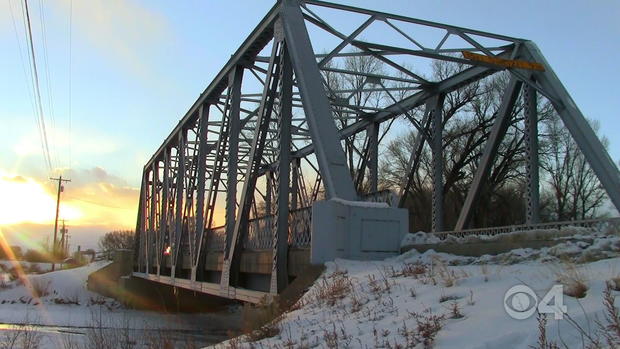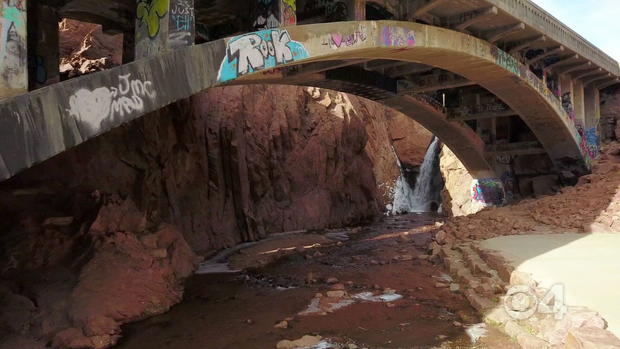Colorado's Endangered Places 2021: Group Of 46 Bridges Spanning The State With Unique History, Architecture
(CBS4)- Some of Colorado's Most Endangered Places include not just one location, but instead a group of 46 bridges. When the railroads removed their train yards, they left behind steel truss bridges.
Rather than remove them, city planners often repurposed them as pedestrian walkways. Now, the Colorado Department of Transportation is taking a similar look at bridges across the state, trying to balance the historic nature of these bridges with the growing transportation needs of Colorado drivers.
One of those bridges is in Red Cliff, rising 209 feet above the Eagle River.
"When you see this bridge, you know you're in Red Cliff," said Kathy Heicher, president of the Eagle County Historical Society. "Bridges can tell stories. As artifacts, they can reveal the history of a county, town, or state."
Heicher says that walking under the arches of the Red Cliff Bridge transporters her back to the 1930s, "The Red Cliff bridge is an artifact that came out of FDR's recovery programs during the Great Depression. That was a time when the federal government kicked in a lot of money for road improvements to jumpstart the economy."
For two years, workers braved frigid temperatures, suspended high above the river below.
"There are stories of workers spending the entire day upon this bridge. They were hoisted up on buckets or platforms," said Heicher. "When the workers left, the Red Cliff kids came down and used the structure like monkey bars on a school playground."
The bridge eliminated two miles of steep, narrow mountain roads.
"A columnist for the state Legislature wrote about, 'This is the end of the white-knuckle driving when you're praying you can get past Red Cliff,'" said Heicher.
Travelers crossing the bridge can appreciate its utility and beauty as they round Battle Mountain. Many times drivers cross bridges without even knowing it.
"Oftentimes we go from point A to point B in a bit of a hurry and we're thinking more about how we get there than what we're looking at while we're in route," said Shoshana Lew, executive director of the Colorado Department of Transportation.
CDOT wants to see more attention placed on historic bridges.
Lew believes the bridges play an important role in cultural identity, "Things like roads and bridges are extremely important for the utility of getting where we need to go today, but they also take us back to periods of time that are foundational for the culture of Colorado."
CDOT studied their bridges with an eye for history and practicality.
"First and foremost, we need it to work," said Lew. "Many of these bridges don't work for today's purposes. You can't just keep them the way they were, and often times it's very expensive to try to upgrade them in place."
CDOT identified 46 bridges in their system that have historic value and a high probability of being preserved.
"The Cherry Creek Bridge was built in 1946," said historian Lisa Schoch. "We were able to preserve the original arch on the bridge while still widening the structure so it could meet current transportation needs."
The bridges come in all different shapes, sizes and materials.
"Zaricillo Canyon Bridge, which is on Highway 12, it's a (Works Progress Administration) bridge. It's built on a skew, it has really beautiful stone-face pillars," said Schoch. "I also love Rainbow Falls... It's tucked away in a canyon, it carries US 24. A lot of people have gone there to put graffiti on our bridge substructure, so it's got this interesting cultural feel to it."
Some bridges were built using local materials, such as volcanic rock on the Rito Seco Creek Bridge in San Luis.
"To me, they're historic properties. To the engineers at CDOT, they're functional transportations features," said Schoch.
For CDOT engineer Michael Collins, that presents a delicate balancing act, "We look at safety demands, we look at conditions."
"Bridges are like an old house. Buying an old house and having that charm and living in it, being able to see it as part of the original design for the landscape where it's located, trying to retain that as much as possible, but being able to update it to today's safety standards and bring able to bring it back to today's functional needs," said Collins.
Meeting those needs creates challenges. For example, those old steel truss bridges have low vertical clearance issues.
"The safety rail, there's no good place to mount it on those bridges, so we have to get creative on how we bring those safety standards back up," said Collins.
Those solutions are not an easy feat or inexpensive.
"Figuring out where you get the most bang for your buck in preserving those links is something that's a challenge for us as we develop our infrastructure," said Lew.
The conversation, CDOT says, is something they are looking forward to continuing with local communities.
"We want people to sort of broaden the spectrum of what can be historic and what is important to state and local history," said Schoch.
"That's why it's important to keep records, preserve where it is possible to preserve, and make sure that these bridges remain a part of Colorado's history," said Heicher.
CDOT hopes the discussion and appreciation of historic bridges spreads to the county and local levels so historic bridges that are not owned by the state can also be preserved.











